Life Cycle Assessment and Energy Efficiency in Sustainability
VerifiedAdded on 2023/03/30
|18
|2430
|265
Report
AI Summary
This report addresses sustainability through two main parts: a life cycle assessment (LCA) of plastic versus metallic mugs and an energy efficiency analysis, particularly focusing on radio usage in Australia. The LCA identifies the environmental impacts of both types of mugs, concluding that metallic mugs are more sustainable due to their recyclability and reduced toxic emissions. The report uses the ISO methodology for LCA, including goal definition, inventory analysis, impact assessment, and interpretation. The energy efficiency analysis highlights the increasing carbon emission levels in Australia and evaluates the environmental impact of radio usage. It suggests alternative energy sources like solar power and promotes switching off electronic appliances when not in use. The report emphasizes the importance of preventive measures over curative approaches in waste management and energy consumption to mitigate environmental damage and promote sustainability.
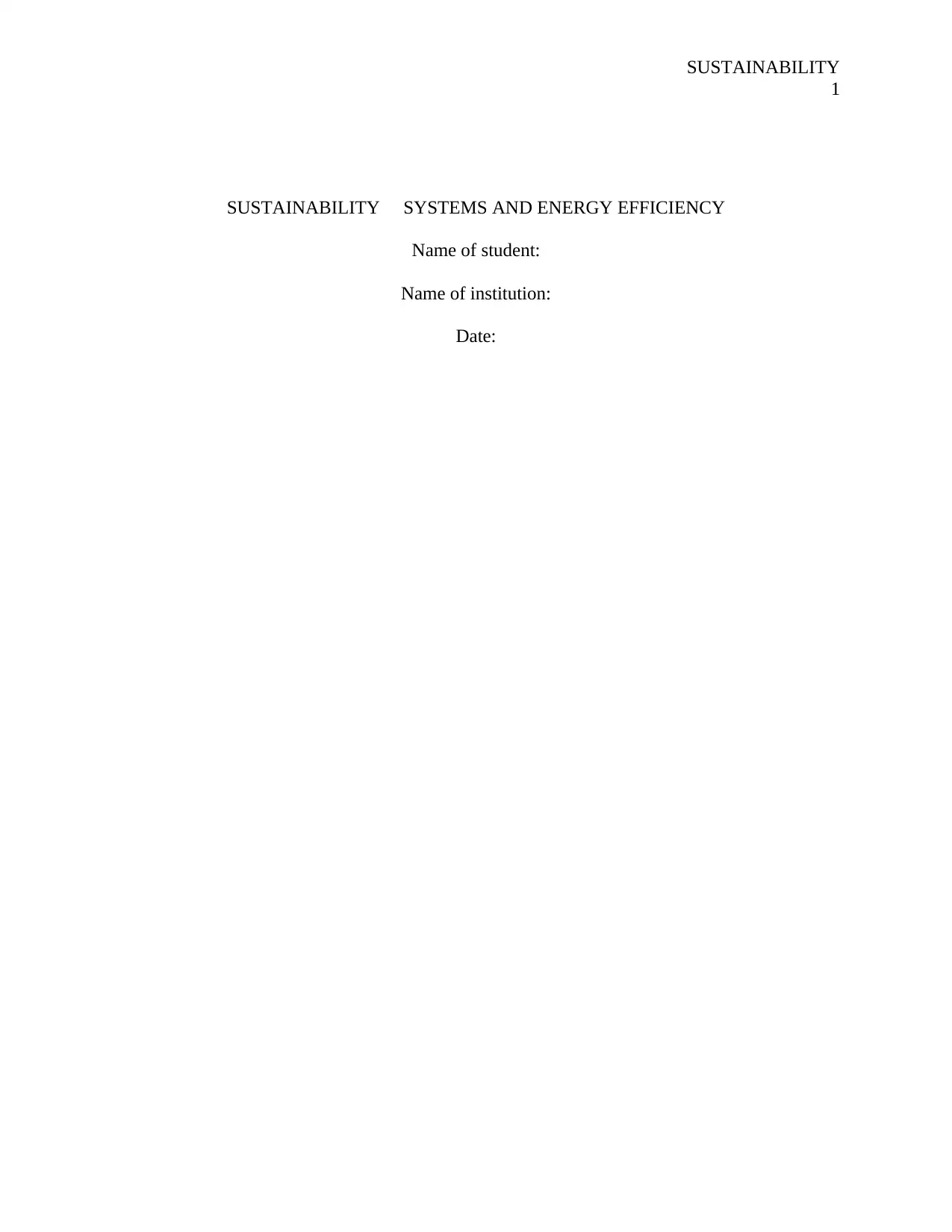
SUSTAINABILITY
1
SUSTAINABILITY SYSTEMS AND ENERGY EFFICIENCY
Name of student:
Name of institution:
Date:
1
SUSTAINABILITY SYSTEMS AND ENERGY EFFICIENCY
Name of student:
Name of institution:
Date:
Paraphrase This Document
Need a fresh take? Get an instant paraphrase of this document with our AI Paraphraser
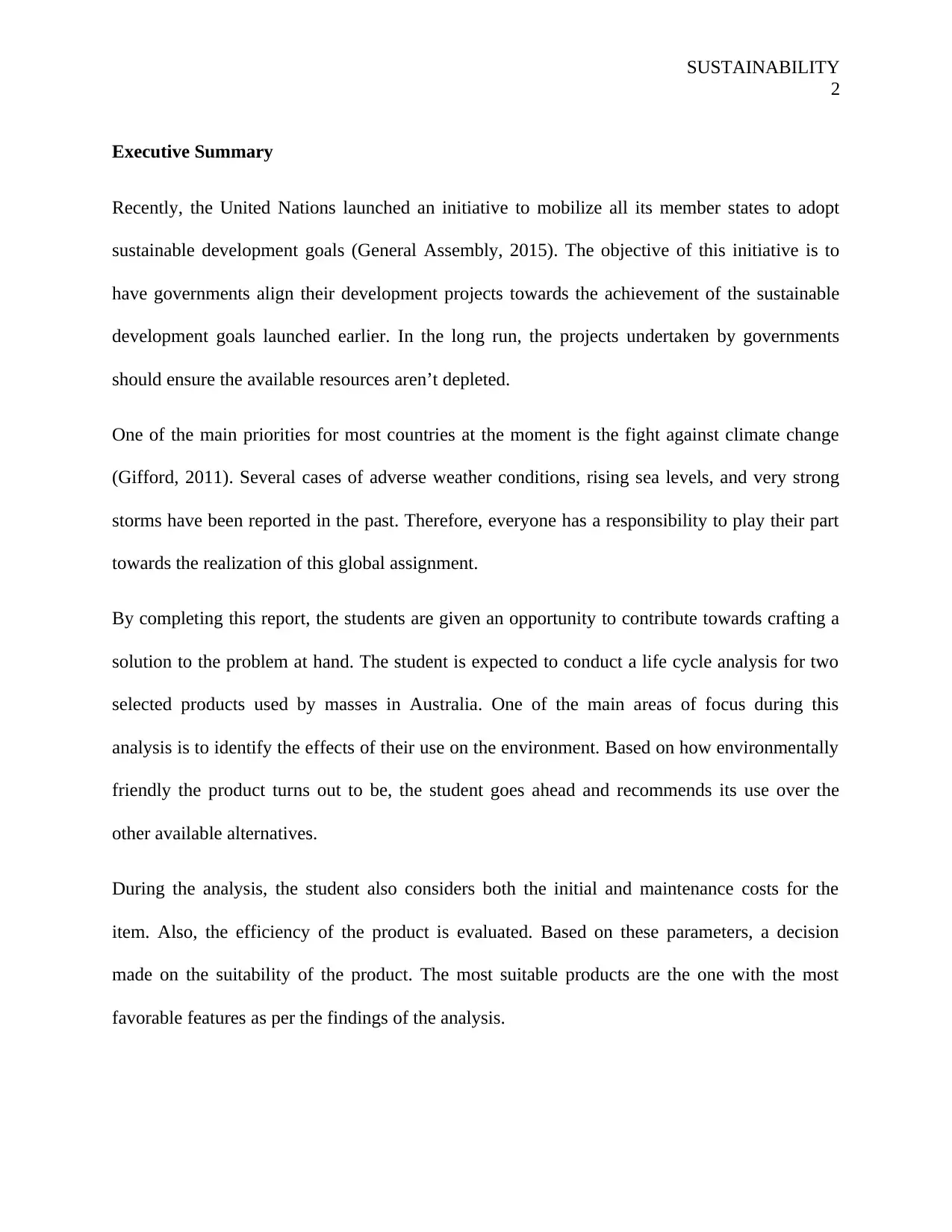
SUSTAINABILITY
2
Executive Summary
Recently, the United Nations launched an initiative to mobilize all its member states to adopt
sustainable development goals (General Assembly, 2015). The objective of this initiative is to
have governments align their development projects towards the achievement of the sustainable
development goals launched earlier. In the long run, the projects undertaken by governments
should ensure the available resources aren’t depleted.
One of the main priorities for most countries at the moment is the fight against climate change
(Gifford, 2011). Several cases of adverse weather conditions, rising sea levels, and very strong
storms have been reported in the past. Therefore, everyone has a responsibility to play their part
towards the realization of this global assignment.
By completing this report, the students are given an opportunity to contribute towards crafting a
solution to the problem at hand. The student is expected to conduct a life cycle analysis for two
selected products used by masses in Australia. One of the main areas of focus during this
analysis is to identify the effects of their use on the environment. Based on how environmentally
friendly the product turns out to be, the student goes ahead and recommends its use over the
other available alternatives.
During the analysis, the student also considers both the initial and maintenance costs for the
item. Also, the efficiency of the product is evaluated. Based on these parameters, a decision
made on the suitability of the product. The most suitable products are the one with the most
favorable features as per the findings of the analysis.
2
Executive Summary
Recently, the United Nations launched an initiative to mobilize all its member states to adopt
sustainable development goals (General Assembly, 2015). The objective of this initiative is to
have governments align their development projects towards the achievement of the sustainable
development goals launched earlier. In the long run, the projects undertaken by governments
should ensure the available resources aren’t depleted.
One of the main priorities for most countries at the moment is the fight against climate change
(Gifford, 2011). Several cases of adverse weather conditions, rising sea levels, and very strong
storms have been reported in the past. Therefore, everyone has a responsibility to play their part
towards the realization of this global assignment.
By completing this report, the students are given an opportunity to contribute towards crafting a
solution to the problem at hand. The student is expected to conduct a life cycle analysis for two
selected products used by masses in Australia. One of the main areas of focus during this
analysis is to identify the effects of their use on the environment. Based on how environmentally
friendly the product turns out to be, the student goes ahead and recommends its use over the
other available alternatives.
During the analysis, the student also considers both the initial and maintenance costs for the
item. Also, the efficiency of the product is evaluated. Based on these parameters, a decision
made on the suitability of the product. The most suitable products are the one with the most
favorable features as per the findings of the analysis.
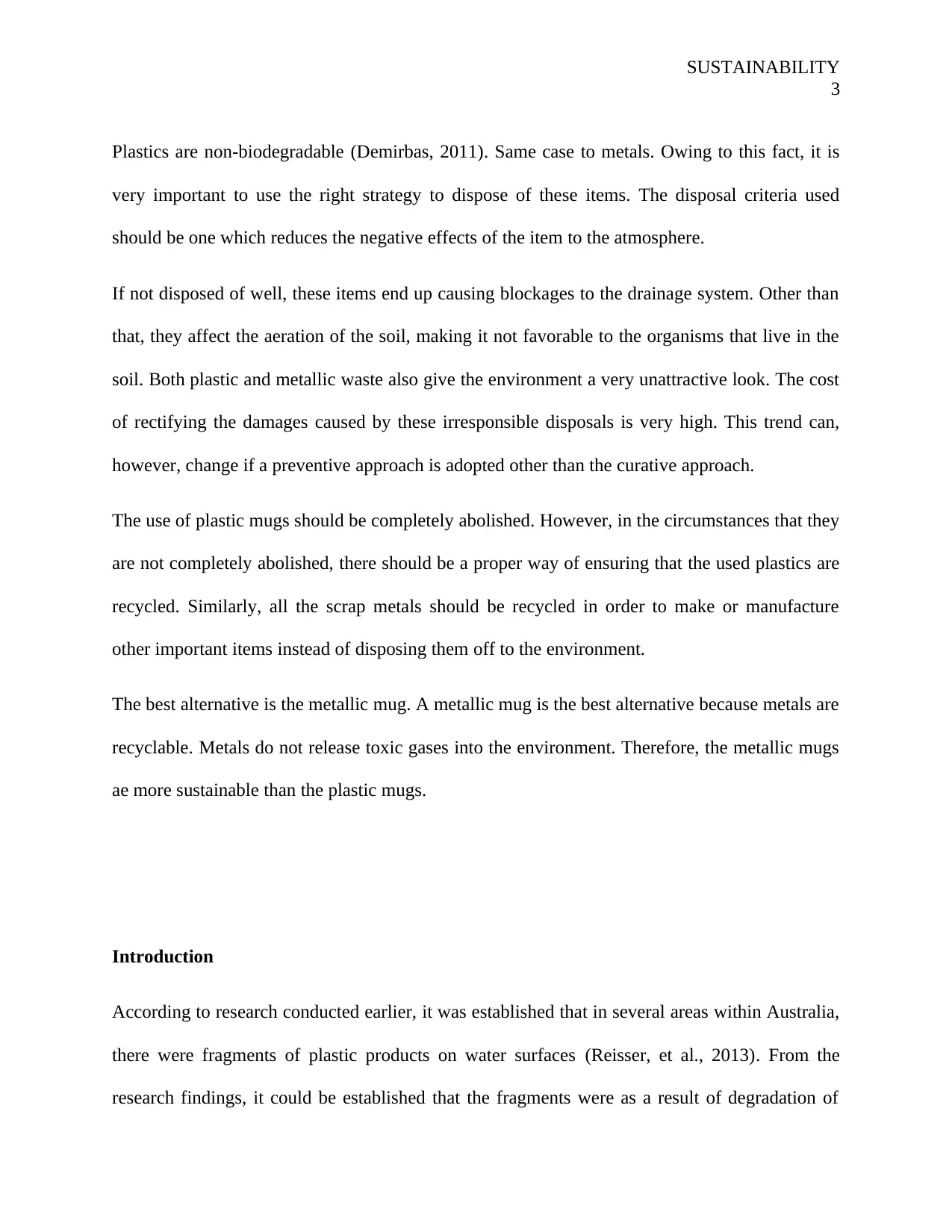
SUSTAINABILITY
3
Plastics are non-biodegradable (Demirbas, 2011). Same case to metals. Owing to this fact, it is
very important to use the right strategy to dispose of these items. The disposal criteria used
should be one which reduces the negative effects of the item to the atmosphere.
If not disposed of well, these items end up causing blockages to the drainage system. Other than
that, they affect the aeration of the soil, making it not favorable to the organisms that live in the
soil. Both plastic and metallic waste also give the environment a very unattractive look. The cost
of rectifying the damages caused by these irresponsible disposals is very high. This trend can,
however, change if a preventive approach is adopted other than the curative approach.
The use of plastic mugs should be completely abolished. However, in the circumstances that they
are not completely abolished, there should be a proper way of ensuring that the used plastics are
recycled. Similarly, all the scrap metals should be recycled in order to make or manufacture
other important items instead of disposing them off to the environment.
The best alternative is the metallic mug. A metallic mug is the best alternative because metals are
recyclable. Metals do not release toxic gases into the environment. Therefore, the metallic mugs
ae more sustainable than the plastic mugs.
Introduction
According to research conducted earlier, it was established that in several areas within Australia,
there were fragments of plastic products on water surfaces (Reisser, et al., 2013). From the
research findings, it could be established that the fragments were as a result of degradation of
3
Plastics are non-biodegradable (Demirbas, 2011). Same case to metals. Owing to this fact, it is
very important to use the right strategy to dispose of these items. The disposal criteria used
should be one which reduces the negative effects of the item to the atmosphere.
If not disposed of well, these items end up causing blockages to the drainage system. Other than
that, they affect the aeration of the soil, making it not favorable to the organisms that live in the
soil. Both plastic and metallic waste also give the environment a very unattractive look. The cost
of rectifying the damages caused by these irresponsible disposals is very high. This trend can,
however, change if a preventive approach is adopted other than the curative approach.
The use of plastic mugs should be completely abolished. However, in the circumstances that they
are not completely abolished, there should be a proper way of ensuring that the used plastics are
recycled. Similarly, all the scrap metals should be recycled in order to make or manufacture
other important items instead of disposing them off to the environment.
The best alternative is the metallic mug. A metallic mug is the best alternative because metals are
recyclable. Metals do not release toxic gases into the environment. Therefore, the metallic mugs
ae more sustainable than the plastic mugs.
Introduction
According to research conducted earlier, it was established that in several areas within Australia,
there were fragments of plastic products on water surfaces (Reisser, et al., 2013). From the
research findings, it could be established that the fragments were as a result of degradation of
⊘ This is a preview!⊘
Do you want full access?
Subscribe today to unlock all pages.

Trusted by 1+ million students worldwide
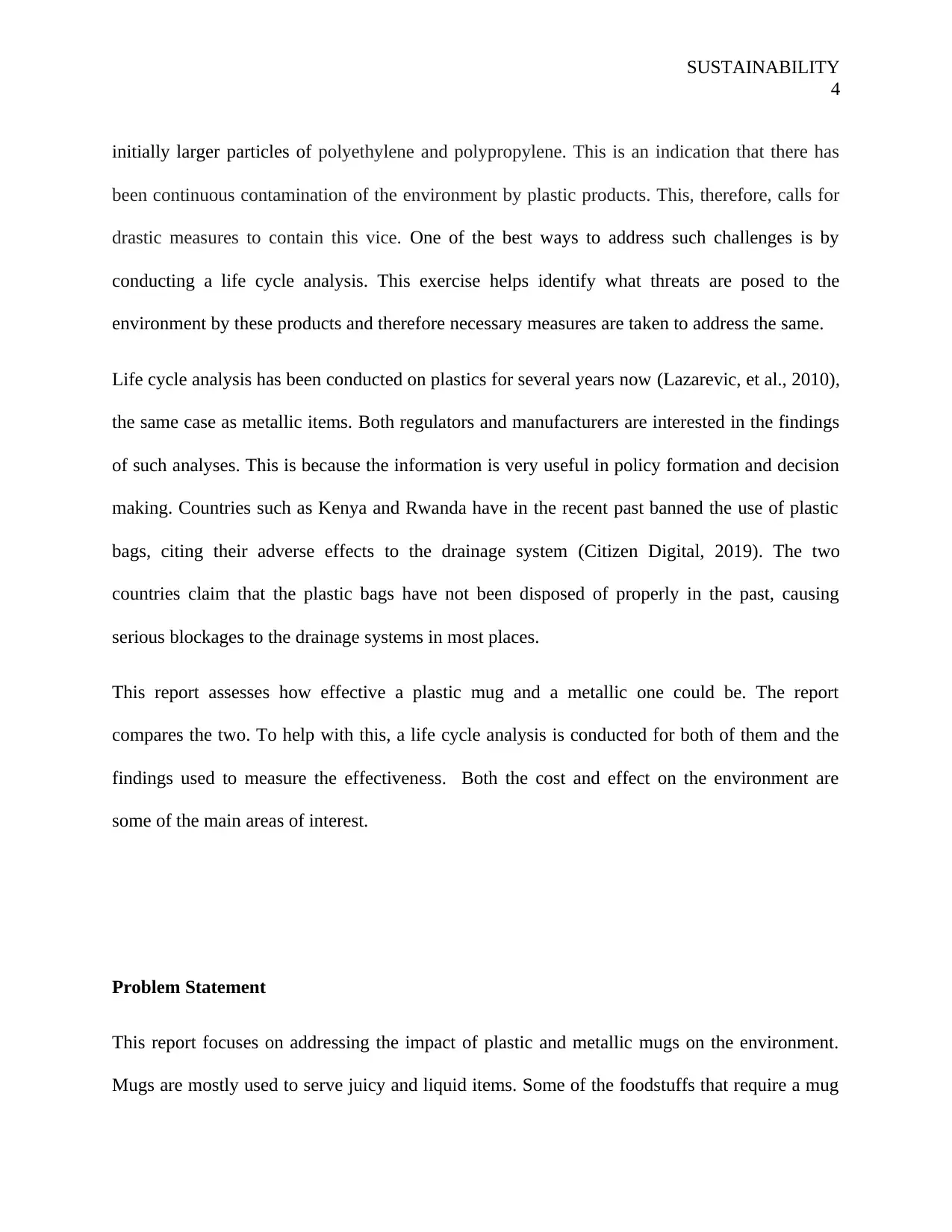
SUSTAINABILITY
4
initially larger particles of polyethylene and polypropylene. This is an indication that there has
been continuous contamination of the environment by plastic products. This, therefore, calls for
drastic measures to contain this vice. One of the best ways to address such challenges is by
conducting a life cycle analysis. This exercise helps identify what threats are posed to the
environment by these products and therefore necessary measures are taken to address the same.
Life cycle analysis has been conducted on plastics for several years now (Lazarevic, et al., 2010),
the same case as metallic items. Both regulators and manufacturers are interested in the findings
of such analyses. This is because the information is very useful in policy formation and decision
making. Countries such as Kenya and Rwanda have in the recent past banned the use of plastic
bags, citing their adverse effects to the drainage system (Citizen Digital, 2019). The two
countries claim that the plastic bags have not been disposed of properly in the past, causing
serious blockages to the drainage systems in most places.
This report assesses how effective a plastic mug and a metallic one could be. The report
compares the two. To help with this, a life cycle analysis is conducted for both of them and the
findings used to measure the effectiveness. Both the cost and effect on the environment are
some of the main areas of interest.
Problem Statement
This report focuses on addressing the impact of plastic and metallic mugs on the environment.
Mugs are mostly used to serve juicy and liquid items. Some of the foodstuffs that require a mug
4
initially larger particles of polyethylene and polypropylene. This is an indication that there has
been continuous contamination of the environment by plastic products. This, therefore, calls for
drastic measures to contain this vice. One of the best ways to address such challenges is by
conducting a life cycle analysis. This exercise helps identify what threats are posed to the
environment by these products and therefore necessary measures are taken to address the same.
Life cycle analysis has been conducted on plastics for several years now (Lazarevic, et al., 2010),
the same case as metallic items. Both regulators and manufacturers are interested in the findings
of such analyses. This is because the information is very useful in policy formation and decision
making. Countries such as Kenya and Rwanda have in the recent past banned the use of plastic
bags, citing their adverse effects to the drainage system (Citizen Digital, 2019). The two
countries claim that the plastic bags have not been disposed of properly in the past, causing
serious blockages to the drainage systems in most places.
This report assesses how effective a plastic mug and a metallic one could be. The report
compares the two. To help with this, a life cycle analysis is conducted for both of them and the
findings used to measure the effectiveness. Both the cost and effect on the environment are
some of the main areas of interest.
Problem Statement
This report focuses on addressing the impact of plastic and metallic mugs on the environment.
Mugs are mostly used to serve juicy and liquid items. Some of the foodstuffs that require a mug
Paraphrase This Document
Need a fresh take? Get an instant paraphrase of this document with our AI Paraphraser
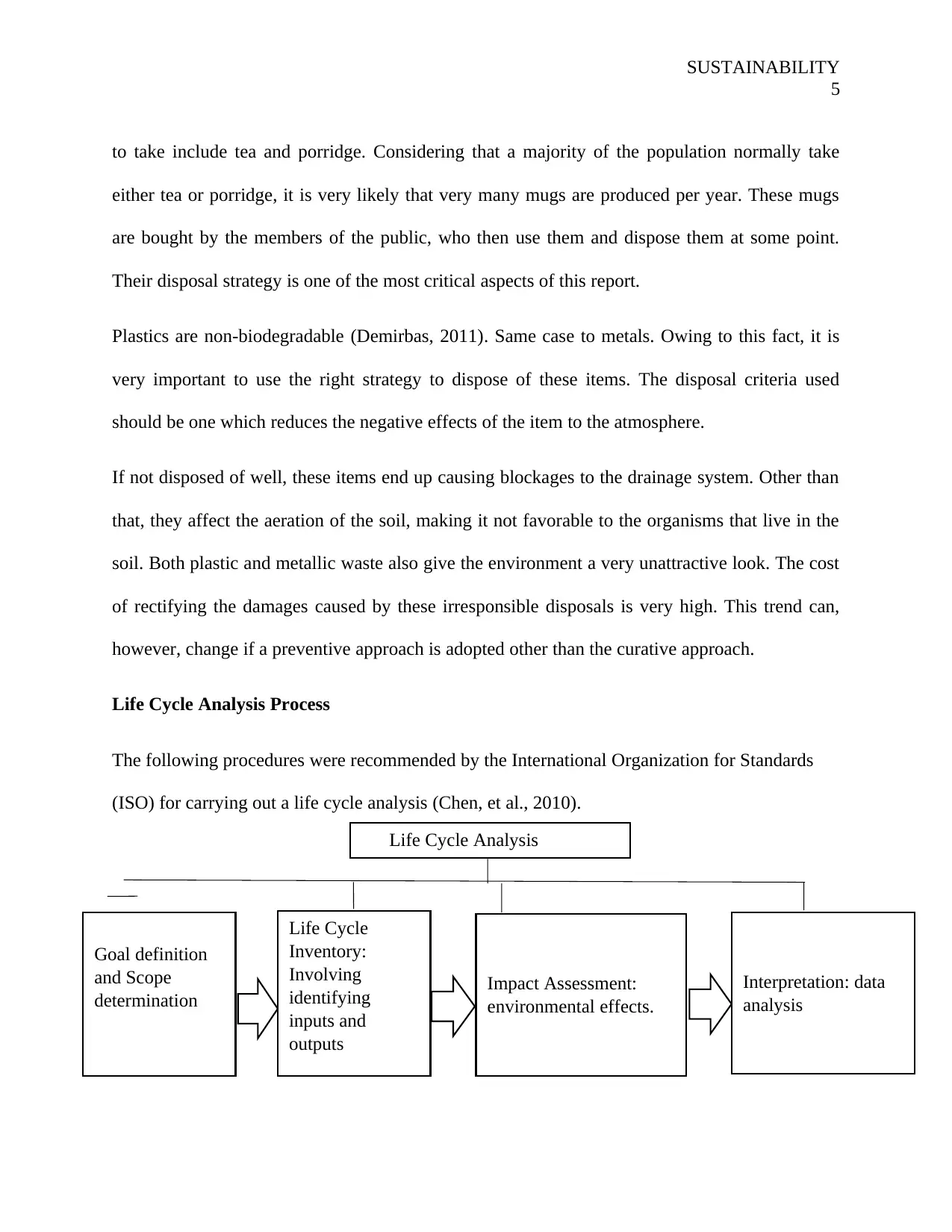
SUSTAINABILITY
5
to take include tea and porridge. Considering that a majority of the population normally take
either tea or porridge, it is very likely that very many mugs are produced per year. These mugs
are bought by the members of the public, who then use them and dispose them at some point.
Their disposal strategy is one of the most critical aspects of this report.
Plastics are non-biodegradable (Demirbas, 2011). Same case to metals. Owing to this fact, it is
very important to use the right strategy to dispose of these items. The disposal criteria used
should be one which reduces the negative effects of the item to the atmosphere.
If not disposed of well, these items end up causing blockages to the drainage system. Other than
that, they affect the aeration of the soil, making it not favorable to the organisms that live in the
soil. Both plastic and metallic waste also give the environment a very unattractive look. The cost
of rectifying the damages caused by these irresponsible disposals is very high. This trend can,
however, change if a preventive approach is adopted other than the curative approach.
Life Cycle Analysis Process
The following procedures were recommended by the International Organization for Standards
(ISO) for carrying out a life cycle analysis (Chen, et al., 2010).
Life Cycle Analysis
Goal definition
and Scope
determination
Life Cycle
Inventory:
Involving
identifying
inputs and
outputs
Impact Assessment:
environmental effects.
Interpretation: data
analysis
5
to take include tea and porridge. Considering that a majority of the population normally take
either tea or porridge, it is very likely that very many mugs are produced per year. These mugs
are bought by the members of the public, who then use them and dispose them at some point.
Their disposal strategy is one of the most critical aspects of this report.
Plastics are non-biodegradable (Demirbas, 2011). Same case to metals. Owing to this fact, it is
very important to use the right strategy to dispose of these items. The disposal criteria used
should be one which reduces the negative effects of the item to the atmosphere.
If not disposed of well, these items end up causing blockages to the drainage system. Other than
that, they affect the aeration of the soil, making it not favorable to the organisms that live in the
soil. Both plastic and metallic waste also give the environment a very unattractive look. The cost
of rectifying the damages caused by these irresponsible disposals is very high. This trend can,
however, change if a preventive approach is adopted other than the curative approach.
Life Cycle Analysis Process
The following procedures were recommended by the International Organization for Standards
(ISO) for carrying out a life cycle analysis (Chen, et al., 2010).
Life Cycle Analysis
Goal definition
and Scope
determination
Life Cycle
Inventory:
Involving
identifying
inputs and
outputs
Impact Assessment:
environmental effects.
Interpretation: data
analysis
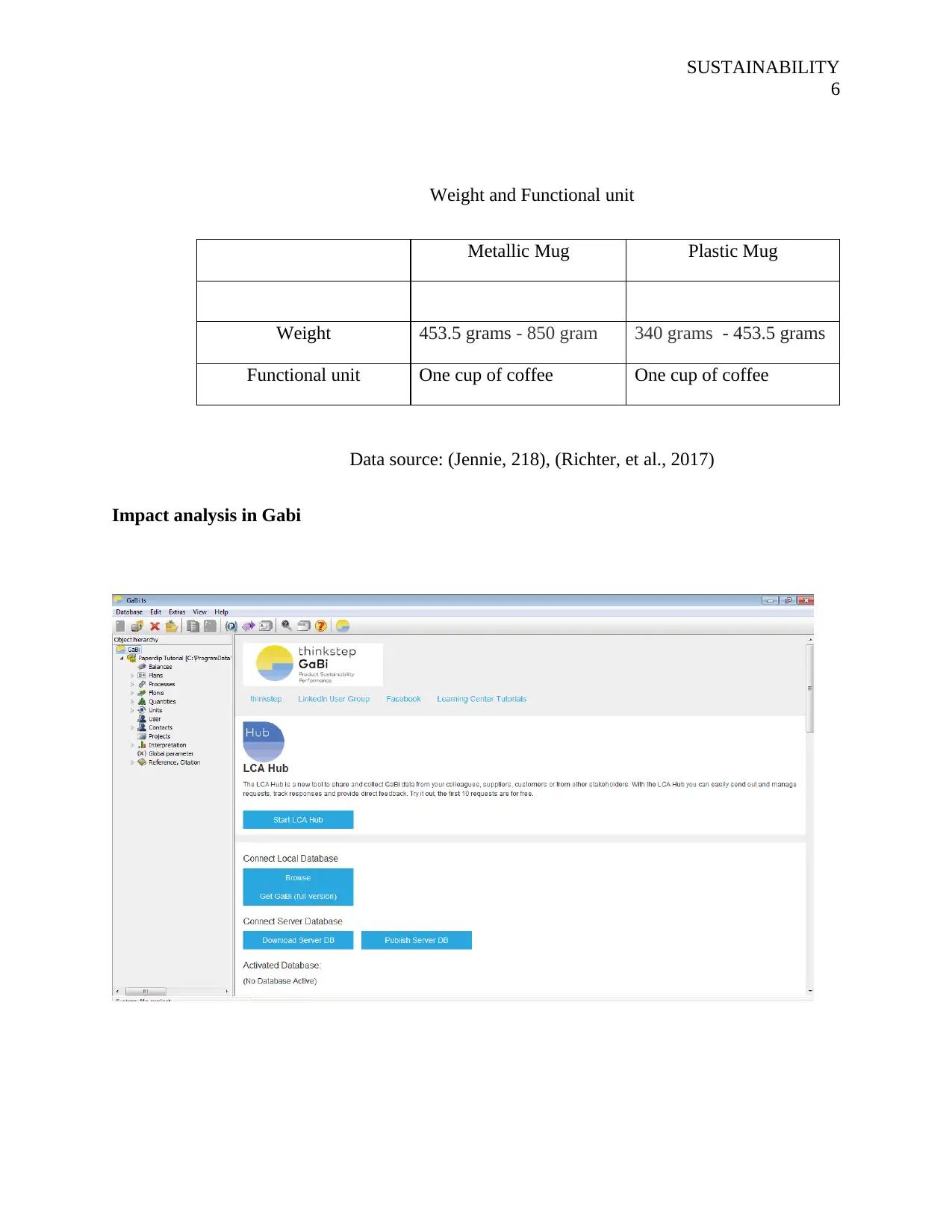
SUSTAINABILITY
6
Weight and Functional unit
Metallic Mug Plastic Mug
Weight 453.5 grams - 850 gram 340 grams - 453.5 grams
Functional unit One cup of coffee One cup of coffee
Data source: (Jennie, 218), (Richter, et al., 2017)
Impact analysis in Gabi
6
Weight and Functional unit
Metallic Mug Plastic Mug
Weight 453.5 grams - 850 gram 340 grams - 453.5 grams
Functional unit One cup of coffee One cup of coffee
Data source: (Jennie, 218), (Richter, et al., 2017)
Impact analysis in Gabi
⊘ This is a preview!⊘
Do you want full access?
Subscribe today to unlock all pages.

Trusted by 1+ million students worldwide
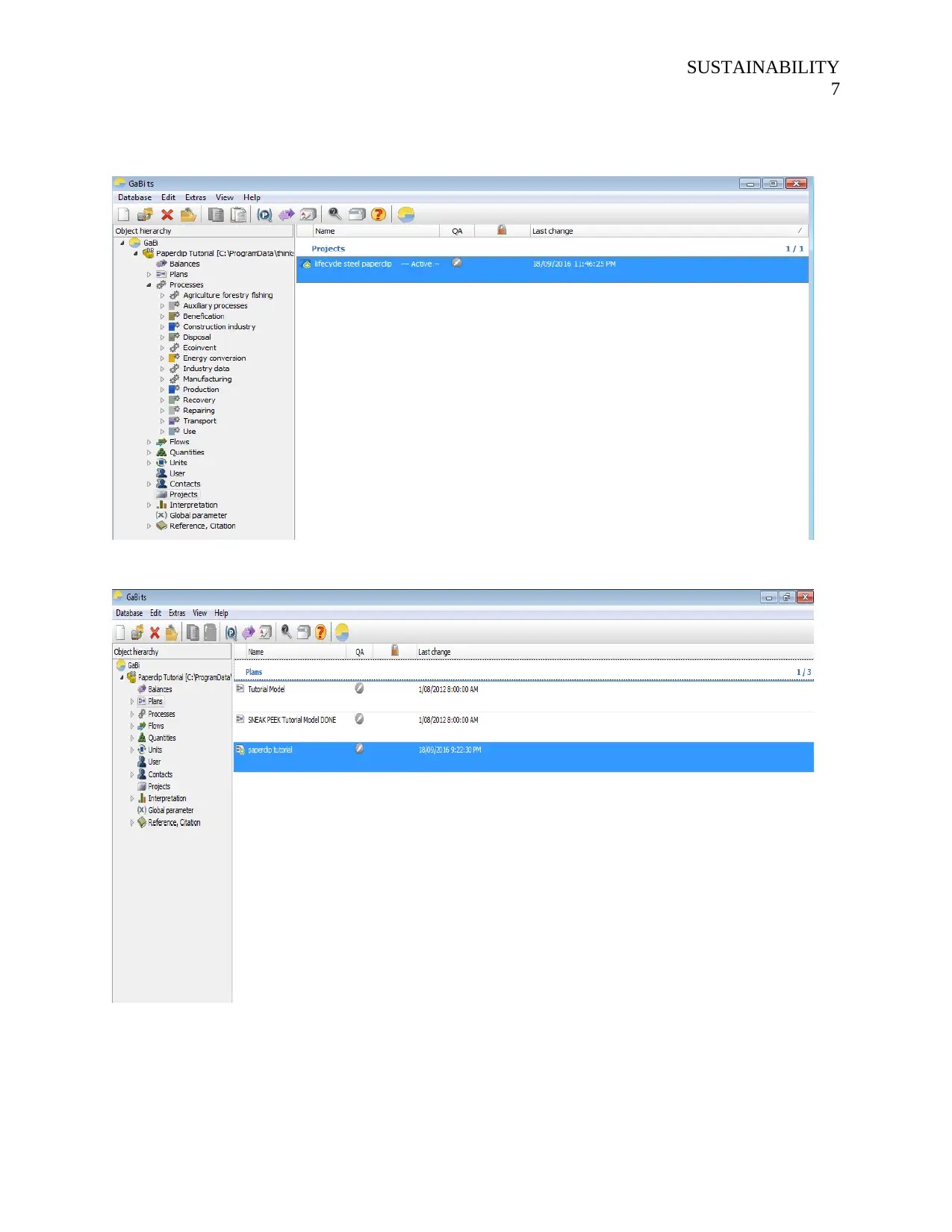
SUSTAINABILITY
7
7
Paraphrase This Document
Need a fresh take? Get an instant paraphrase of this document with our AI Paraphraser
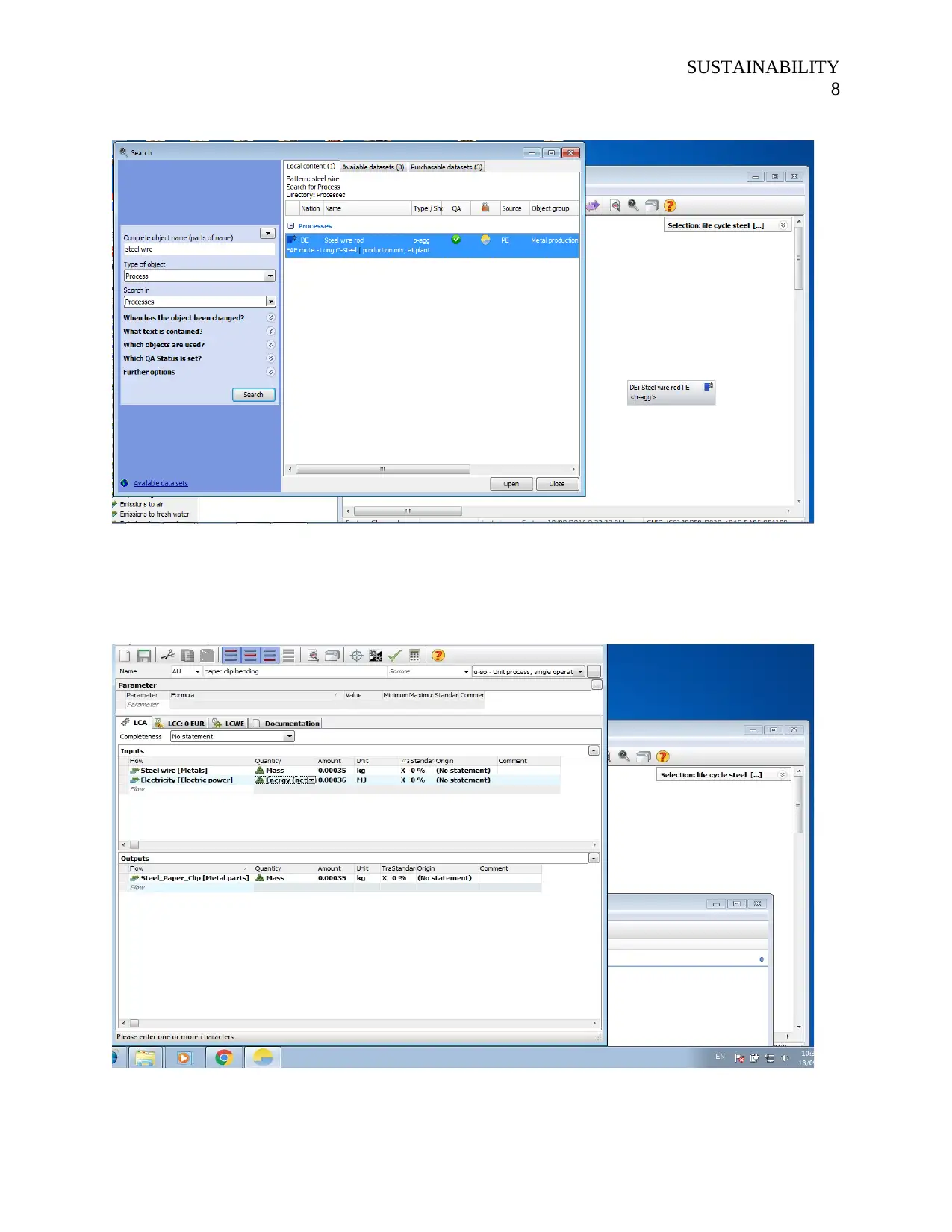
SUSTAINABILITY
8
8
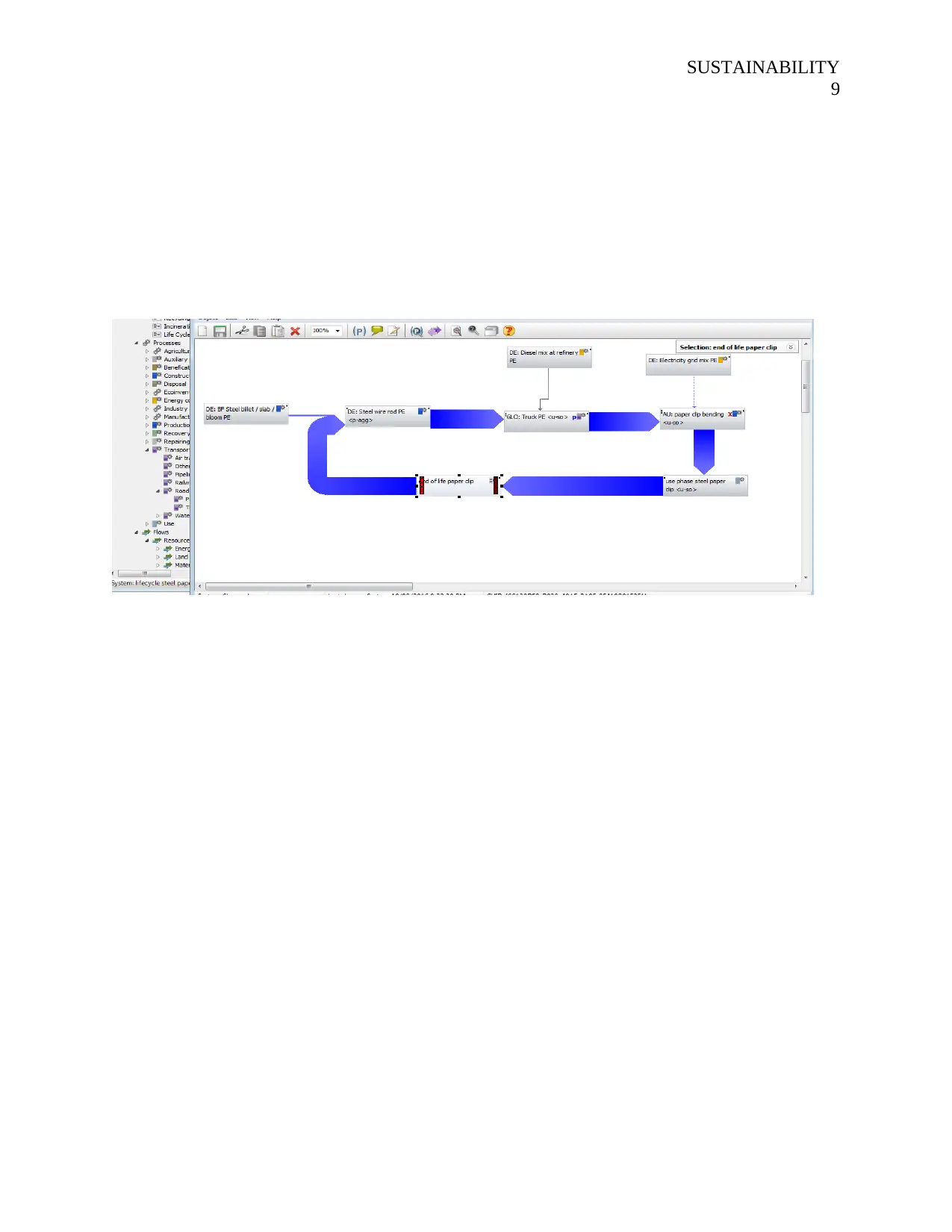
SUSTAINABILITY
9
9
⊘ This is a preview!⊘
Do you want full access?
Subscribe today to unlock all pages.

Trusted by 1+ million students worldwide
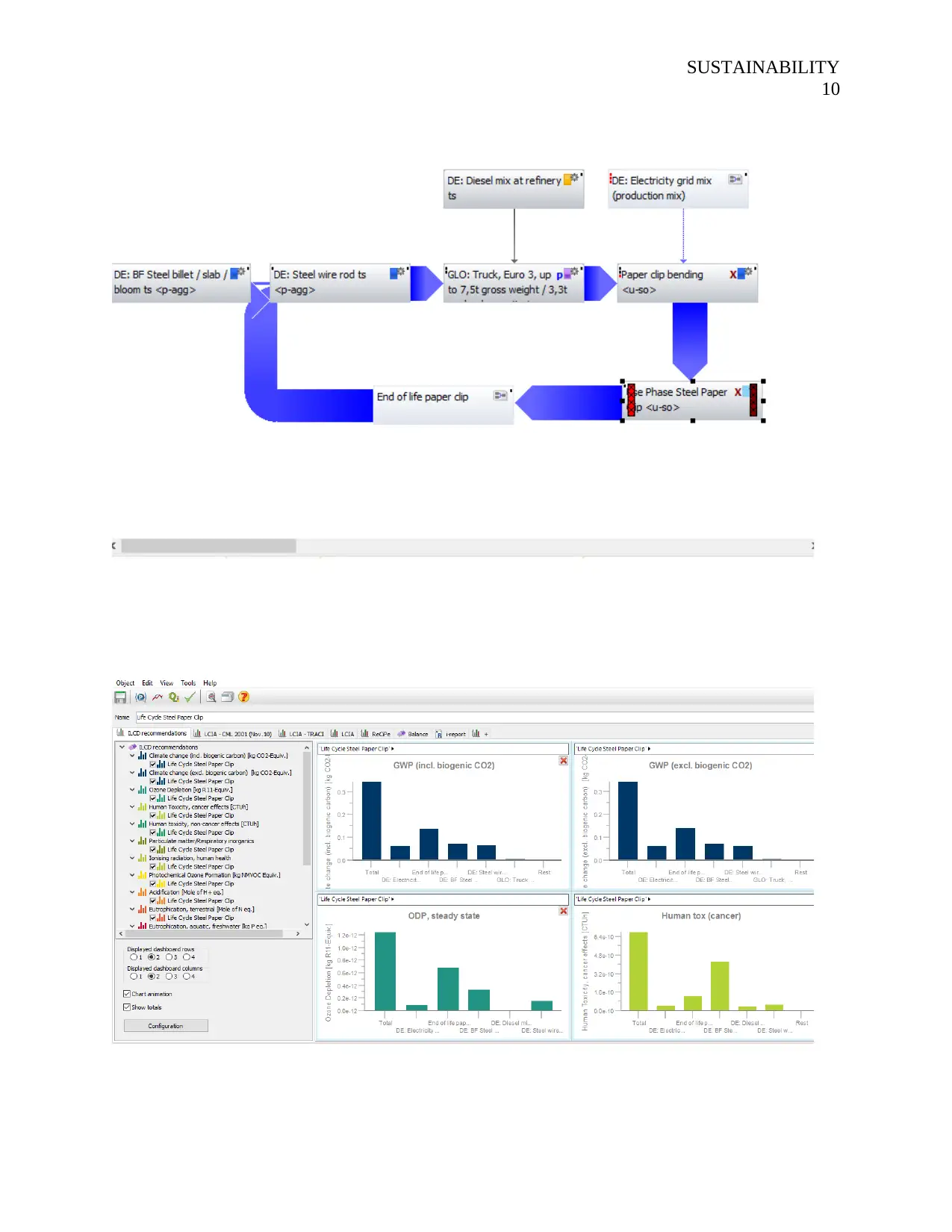
SUSTAINABILITY
10
10
Paraphrase This Document
Need a fresh take? Get an instant paraphrase of this document with our AI Paraphraser
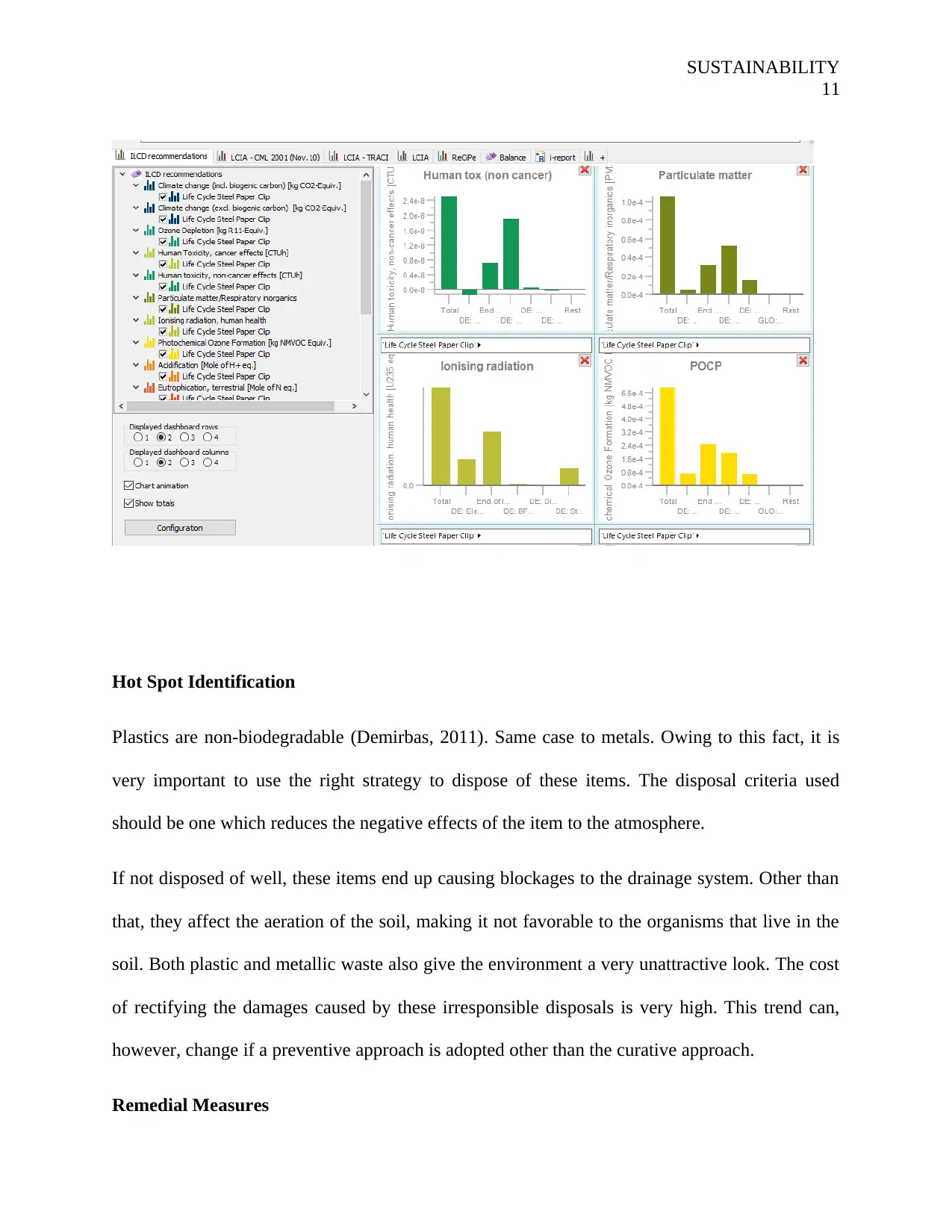
SUSTAINABILITY
11
Hot Spot Identification
Plastics are non-biodegradable (Demirbas, 2011). Same case to metals. Owing to this fact, it is
very important to use the right strategy to dispose of these items. The disposal criteria used
should be one which reduces the negative effects of the item to the atmosphere.
If not disposed of well, these items end up causing blockages to the drainage system. Other than
that, they affect the aeration of the soil, making it not favorable to the organisms that live in the
soil. Both plastic and metallic waste also give the environment a very unattractive look. The cost
of rectifying the damages caused by these irresponsible disposals is very high. This trend can,
however, change if a preventive approach is adopted other than the curative approach.
Remedial Measures
11
Hot Spot Identification
Plastics are non-biodegradable (Demirbas, 2011). Same case to metals. Owing to this fact, it is
very important to use the right strategy to dispose of these items. The disposal criteria used
should be one which reduces the negative effects of the item to the atmosphere.
If not disposed of well, these items end up causing blockages to the drainage system. Other than
that, they affect the aeration of the soil, making it not favorable to the organisms that live in the
soil. Both plastic and metallic waste also give the environment a very unattractive look. The cost
of rectifying the damages caused by these irresponsible disposals is very high. This trend can,
however, change if a preventive approach is adopted other than the curative approach.
Remedial Measures
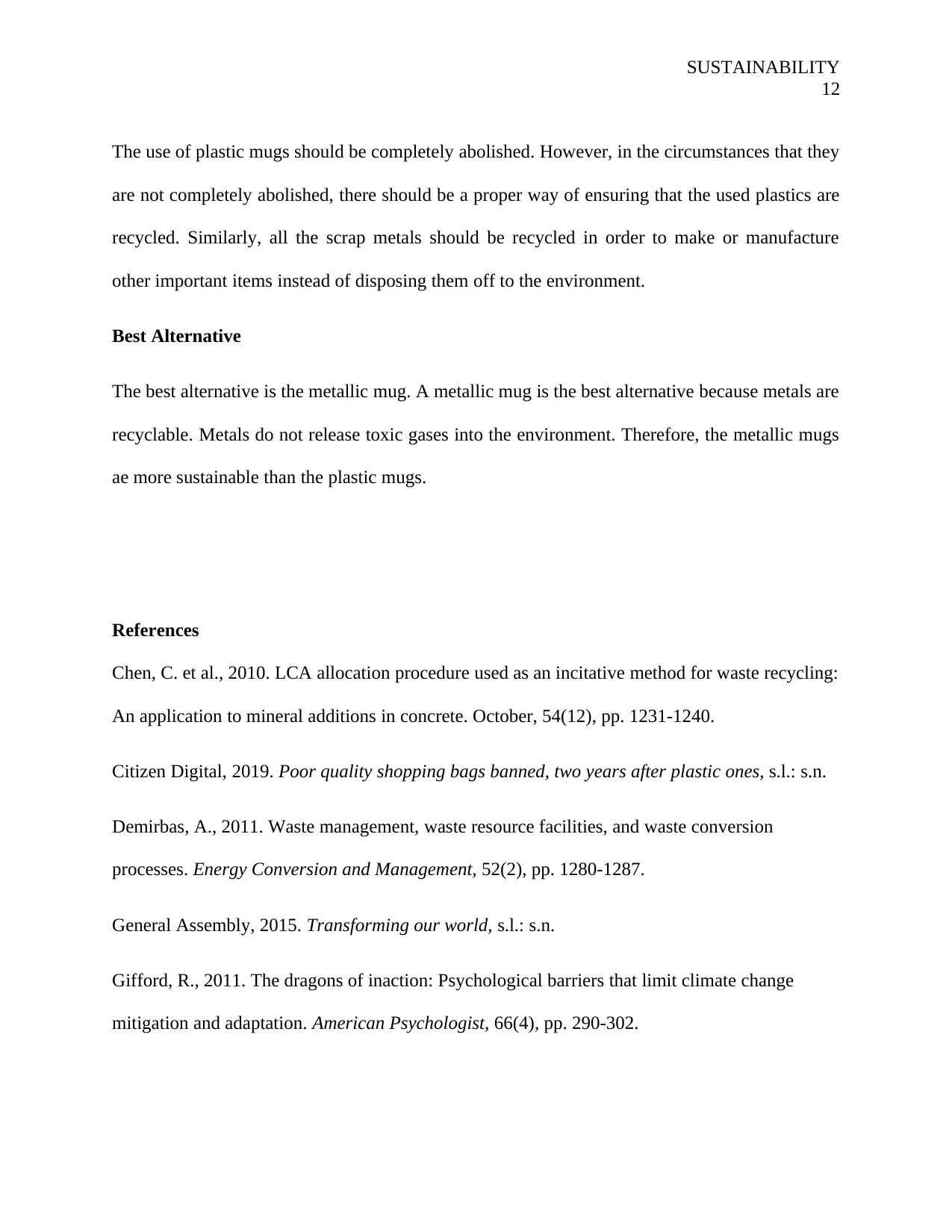
SUSTAINABILITY
12
The use of plastic mugs should be completely abolished. However, in the circumstances that they
are not completely abolished, there should be a proper way of ensuring that the used plastics are
recycled. Similarly, all the scrap metals should be recycled in order to make or manufacture
other important items instead of disposing them off to the environment.
Best Alternative
The best alternative is the metallic mug. A metallic mug is the best alternative because metals are
recyclable. Metals do not release toxic gases into the environment. Therefore, the metallic mugs
ae more sustainable than the plastic mugs.
References
Chen, C. et al., 2010. LCA allocation procedure used as an incitative method for waste recycling:
An application to mineral additions in concrete. October, 54(12), pp. 1231-1240.
Citizen Digital, 2019. Poor quality shopping bags banned, two years after plastic ones, s.l.: s.n.
Demirbas, A., 2011. Waste management, waste resource facilities, and waste conversion
processes. Energy Conversion and Management, 52(2), pp. 1280-1287.
General Assembly, 2015. Transforming our world, s.l.: s.n.
Gifford, R., 2011. The dragons of inaction: Psychological barriers that limit climate change
mitigation and adaptation. American Psychologist, 66(4), pp. 290-302.
12
The use of plastic mugs should be completely abolished. However, in the circumstances that they
are not completely abolished, there should be a proper way of ensuring that the used plastics are
recycled. Similarly, all the scrap metals should be recycled in order to make or manufacture
other important items instead of disposing them off to the environment.
Best Alternative
The best alternative is the metallic mug. A metallic mug is the best alternative because metals are
recyclable. Metals do not release toxic gases into the environment. Therefore, the metallic mugs
ae more sustainable than the plastic mugs.
References
Chen, C. et al., 2010. LCA allocation procedure used as an incitative method for waste recycling:
An application to mineral additions in concrete. October, 54(12), pp. 1231-1240.
Citizen Digital, 2019. Poor quality shopping bags banned, two years after plastic ones, s.l.: s.n.
Demirbas, A., 2011. Waste management, waste resource facilities, and waste conversion
processes. Energy Conversion and Management, 52(2), pp. 1280-1287.
General Assembly, 2015. Transforming our world, s.l.: s.n.
Gifford, R., 2011. The dragons of inaction: Psychological barriers that limit climate change
mitigation and adaptation. American Psychologist, 66(4), pp. 290-302.
⊘ This is a preview!⊘
Do you want full access?
Subscribe today to unlock all pages.

Trusted by 1+ million students worldwide
1 out of 18
Related Documents
Your All-in-One AI-Powered Toolkit for Academic Success.
+13062052269
info@desklib.com
Available 24*7 on WhatsApp / Email
![[object Object]](/_next/static/media/star-bottom.7253800d.svg)
Unlock your academic potential
Copyright © 2020–2025 A2Z Services. All Rights Reserved. Developed and managed by ZUCOL.




